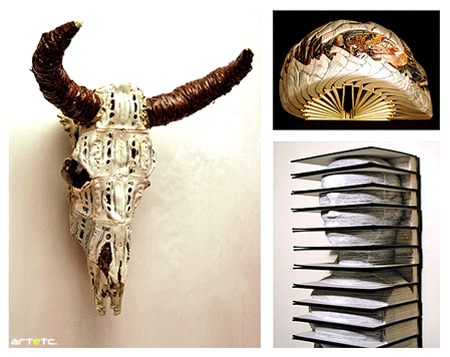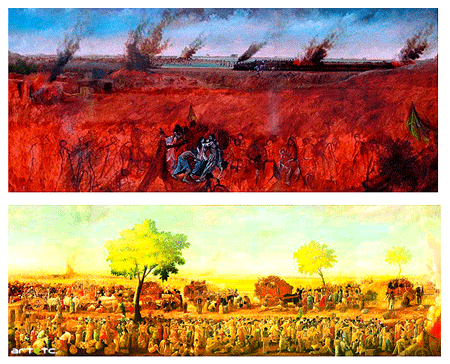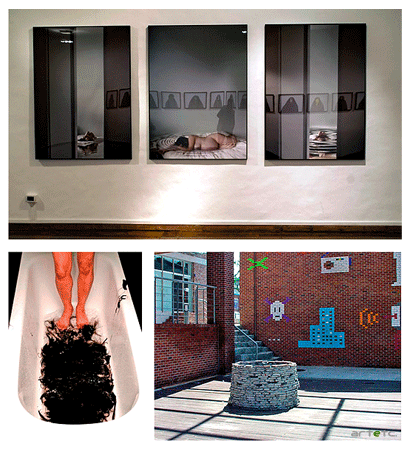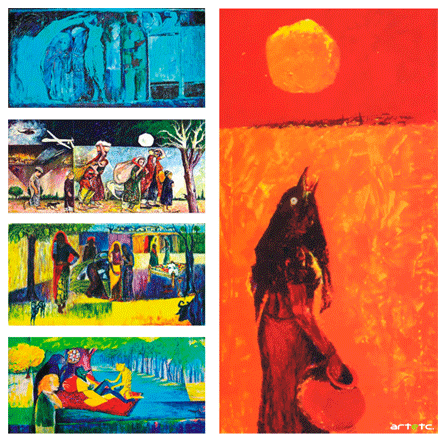- Editorial
- Shibu Natesan Speaks on Protest Art
- Rising Against Rambo: Political Posters Against US Aggression
- Transient Imageries and Protests (?)
- The Inner Voice
- Bhopal – A Third World Narrative of Pain and Protest
- Buddha to Brecht: The Unceasing Idiom of Protest
- In-between Protest and Art
- Humour at a Price: Cartoons of Politics and the Politics of Cartoons
- Fernando Botero's Grievous Depictions of Adversity at the Abu Ghraib
- Up Against the Wall
- Rage Against the Machine: Moments of Resistance in Contemporary Art
- Raoul Hausmann: The Dadaist Who Redefined the Idea of Protests
- When Saying is Protesting -
- Graffiti Art: The Emergence of Daku on Indian Streets
- State Britain: Mark Wallinger
- Bijon Chowdhury: Painting as Social Protest and Initiating an Identity
- A Black Friday and the Spirit of Sharmila: Protest Art of North East India
- Ratan Parimoo: Paintings from the 1950s
- Mahendra Pandya's Show 'Kshudhit Pashan'
- Stunning Detours of Foam and Latex Lynda Benglis at Thomas Dane Gallery, London
- An Inspired Melange
- Soaked in Tranquility
- National Museum of Art, Osaka A Subterranean Design
- Cartier: "Les Must de Cartier"
- Delfina Entrecanales – 25 Years to Build a Legend
- Engaging Caricatures and Satires at the Metropolitan Museum
- The Mesmerizing World of Japanese Storytelling
- The Metropolitan Museum of Art Exhibiting Lyrical Visions: Paintings from North India
- Random Strokes
- Asia Week at New York
- Virtue of the Virtual
- What Happened and What's Forthcoming
- Art Events Kolkata, March – April 2012
- Mumbai Art Sighting
- Art Bengaluru
- Delhi Dias
- Preview, April, 2012 – May, 2012
- In the News, April 2012
- Cover
ART news & views
Random Strokes
Issue No: 28 Month: 5 Year: 2012
by Rumi Banerjee
Layered Fragments of a Magician
Trust me...this time it's going to be different...
 Brian Dettmer, an American contemporary artist, is distinguished for his curious talent of re-using old and worn-out materials, such as old books, maps, record albums and cassette tapes, to create something different from its original form, thus giving it a unique new look and transforming it into something that it was not.
Brian Dettmer, an American contemporary artist, is distinguished for his curious talent of re-using old and worn-out materials, such as old books, maps, record albums and cassette tapes, to create something different from its original form, thus giving it a unique new look and transforming it into something that it was not.
He was born in 1974 and raised in Naperville, Illinois. He earned a B A in fine arts from Columbia College, Chicago in 1997. During school and following graduation, Dettmer worked as an artist and his art was related to graphics and signage design. Later, he began to explore the relationship between text, images, languages and codes including Braille, Morse code, and American Sign Language. His experiments covered a wide range from repeatedly pasting newspapers and book pages on canvas to tearing of pieces and leaving behind layered fragments. He started to experiment by gluing and cutting into books for which he is known now. He alters and changes the physical forms and attributes of a given media and ends up magically by creating an entirely new visual work of art. Dettmer explains: “Old books, records, tapes, maps and other media frequently fall into a realm that too much of today's art occupies. Their intended role has decreased or deceased and they often exist simply as symbols of the ideas they represent rather than true conveyers of content. ...When an object's intended function is fleeting, the necessity for a new approach to its form and content arises.” (Valdez, 2006).
Dettmer has enhanced his artistic experiments by folding, bending, rolling or stacking one or more books before sealing and cutting them or, in some instances, sanding them to create a variety of forms. New Books of Knowledge is a recent example of a sculpture created by Dettmer using a full set of encyclopaedias.
The Last Burning Train
Against a smoke of silence.....
 He is a philanthropist and a crusader, his altruism, his humanity and multi-ethnicity define his art. His art is his essays on life. Colours and forms are carefully chosen like words and their construction. His paintings reveal the echo of time. He has made over 2000 painting, 100 calligraphies and about 20,000 prints, which are now in private collections around the world including Italy, France, Switzerland, China, India, Pakistan, Russia, UK and US. His famous work is the one depicting Partition, which is at the National Art Gallery in Islamabad. He even, designed a number of stamps. Jimmy Engineer was born in 1954 in Balochistan (Loralai), Pakistan. He broke up all the barriers of caste and creed and reached out to all kinds of people in all spheres of life.
He is a philanthropist and a crusader, his altruism, his humanity and multi-ethnicity define his art. His art is his essays on life. Colours and forms are carefully chosen like words and their construction. His paintings reveal the echo of time. He has made over 2000 painting, 100 calligraphies and about 20,000 prints, which are now in private collections around the world including Italy, France, Switzerland, China, India, Pakistan, Russia, UK and US. His famous work is the one depicting Partition, which is at the National Art Gallery in Islamabad. He even, designed a number of stamps. Jimmy Engineer was born in 1954 in Balochistan (Loralai), Pakistan. He broke up all the barriers of caste and creed and reached out to all kinds of people in all spheres of life.
A peace-loving man, and is generally known as Pakistan's unfaltering advocate for the demoralized, disabled, psychologically handicapped, bankrupt and for all who need him as he has the skill to communicate with people from all walks of life. Jimmy's many 'walk-a-cause' have earned him a special position amongst Pakistan's philanthropists. He has undertaken long, strenuous journeys on foot to generate awareness for many humanitarian causes.
Saying about his paintings, he is a master in many mediums and forms. His realism in water, oil, pastels etc. on canvas, wood or ceramics, explored and introduced numerous textures in his works with the amazing versatility. His collection also includes miniatures and self-portraits, many of which are in private collections in almost in every part of the world, validating his status as an International artist. For Jimmy, Pakistan is his only identity and he will continue to work towards merging all cultures that will establish friendship and goodwill among different nations. Like an angel, he spreads love wherever he goes, and is incessantly pursuing the route of charity as he sold his heart to humanity for the rest of his life.
The Call
Hello...is it me you are looking for?
 She lives and works in Gothenburg and wondered what would happen if there was a well that linked us together from one end of the globe to the other? What if unexpected direct communications suddenly happened between the average people in the different parts of the globe? A sculptor, a visual and installation artist Mandana Moghaddam is a Swedish-Iranian artist, born in Teheran in 1962, who serves as a link between people in Sweden with people in a square in Tehran. Her installation The Well symbolizes the only means of connection between the strangers residing in the different parts of this globe. Speaking or shouting while standing in front of the well will produce a reaction from the other end. People residing at the other end of the globe can hear the voice from this side and thus can get connected to those who are trying to speak to them. The installation emphasizes the importance of the cross-border cultural communication in a multicultural, global society. The Well gives the vision that people can come together despite political, religious, cultural distance and boundaries.
She lives and works in Gothenburg and wondered what would happen if there was a well that linked us together from one end of the globe to the other? What if unexpected direct communications suddenly happened between the average people in the different parts of the globe? A sculptor, a visual and installation artist Mandana Moghaddam is a Swedish-Iranian artist, born in Teheran in 1962, who serves as a link between people in Sweden with people in a square in Tehran. Her installation The Well symbolizes the only means of connection between the strangers residing in the different parts of this globe. Speaking or shouting while standing in front of the well will produce a reaction from the other end. People residing at the other end of the globe can hear the voice from this side and thus can get connected to those who are trying to speak to them. The installation emphasizes the importance of the cross-border cultural communication in a multicultural, global society. The Well gives the vision that people can come together despite political, religious, cultural distance and boundaries.
Her Manije I, II & III series depicts the psychological state of a woman during pregnancy. When her emotional state constantly shaping and breaking itself like a whirlpool where expectation, love, fulfilment, anxiety and agony, exist equally though opposite in nature. The privacy of bedroom, the warmth of romance, the heightened pleasure of creation and the circle of life around her makes her existence complete and meaningful. Her life seems full to the brim....but then again the anxiety overpowers....the uncertainty of everything hovers over her mind...the doubt keeps coming....the doubt and fear... unseen and unadmitted....who is she beyond all these? Who is she without all these? For how long this period of glory will surround her like a circle of light? She is afraid to ask these questions to herself in the fear of being exposed to reality.
A Spiritual Voyage
“He has emerged from yellow and the ochre, only to plunge into blue and red”.-S Nayab Hussain
 Known for his socio-political theme, this Pakistani painter held one-man exhibitions since 1958. He was a professor at the University of Sindh in Jamshoro, Pakistan where he founded and headed the department of fine arts. He was honoured with President's Pride of Performance Award on 14th August 2010. Prof. Abdul Rahim Nagori was born in 1939 inheriting roots from Rajasthan, Sorath and Sindh.
Known for his socio-political theme, this Pakistani painter held one-man exhibitions since 1958. He was a professor at the University of Sindh in Jamshoro, Pakistan where he founded and headed the department of fine arts. He was honoured with President's Pride of Performance Award on 14th August 2010. Prof. Abdul Rahim Nagori was born in 1939 inheriting roots from Rajasthan, Sorath and Sindh.
His canvases reflect his researches on the lives of the Nomadic tribes of Sindh, Bheels, Kohlis and Meghwads – the exploited and the ignored. He dedicated his canvases to their miseries. An intense observer and an enthusiastic reader of books Nagori despises violation of basic human rights. Nothing can be more apt than to quote his own words to describe his works.
“My paintings are but expressions of the aspirations of the oppressed majority around me. They are reflections of a society in need of social change. The geographical, socio-political and religious environments, consciously or unconsciously, impart character and style to any work of art. Despite the sanctions of the obscurantists, the contributions of Muslims to the fine arts are indisputable. Art in Muslim countries bears a distinct imprint of the political conditions that have a bearing on the sensitivity of the artist. Yet it would be a misnomer to talk about Islamic Art. Can one call Mughal paintings 'Islamic', since the Mughal School of art composed many Hindu artists, and their subject matter was secular? While other religions used art as the expression and propagation of their faith, art under Islam did not take this path-it is truly secular, and has resisted all attempts to follow the prescriptions of religious doctrines.” – A R Nagori.
As Hussain rightly says that Nagori's canvases continues to be as disturbing as ever. His blue is agonizingly serene, and his red tantalizingly dramatic. Finally, “his blue dips its fingers into green and his red burrows its head under mystery, suspense and drama.”